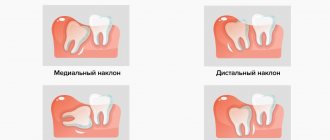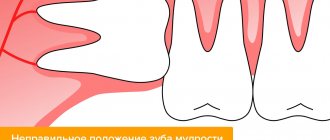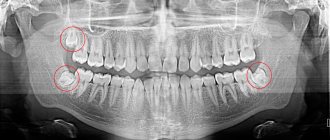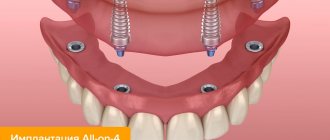Is it painful to remove a wisdom tooth from above?
The bone tissue of the upper jaw is not as dense as the tissue of the lower jaw. Additionally, superior figure eights typically have less tortuous roots than lower molars. Therefore, local anesthesia can completely relieve the patient of pain during surgery. This is confirmed by reviews of people who have already had an upper wisdom tooth pulled out. They note that the most unpleasant, but quite tolerable sensations were experienced when the anesthetic was administered. And the removal itself was absolutely painless.
It can really hurt those patients who put off visiting the doctor for a long time. And all this time they took painkillers. Local anesthesia also has a very bad effect on people who use drugs.
Anesthesia
Almost always, the nerve is removed under local anesthesia; usually, instead of the upcoming operation, the required dose of the drug is administered using a syringe. Immediately before the injection, the gums are treated with a special spray or gel containing an anesthetic, so even the slightest discomfort is eliminated. The needles used are as thin as possible.
There are several of the most common drugs used by dentists for pain relief: mepivacaine, ultracaine, articaine with epinephrine or pure. These products prevent the onset of pain; they are suitable even for people with chronic diseases, pregnant women and those prone to allergic reactions.
A gel with lidocaine is also actively used, which is placed around the diseased tooth. In this case, the patient feels as relaxed as possible and does not have any unpleasant sensations. In rare cases, pain may occur due to an incorrectly administered drug or due to the individual reaction of the patient's body. If you have a strong fear of dentists or serious psychological disorders, nerve removal can be performed under general anesthesia.
Is it painful to remove a wisdom tooth from below?
Reviews about the removal of lower wisdom teeth are very contradictory. Some talk about the complete painlessness of the operation, others remember the minutes spent in the chair with a shudder. The fact is that when a wisdom tooth is removed from below, the patient’s sensations directly depend on the professionalism of the doctor.
Thus, infiltration anesthesia in the upper jaw is carried out in the gum in the area of the root of the wisdom tooth. And in the case of the lower “eight”, the dentist has to give an injection from the inside of the jaw. Carrying out such anesthesia is technically more difficult, and, alas, not all dentists are fluent in it.
If modern anesthetics are used, and the doctor is a professional in his field, pain during the removal of the lower wisdom tooth is completely eliminated.
It may hurt a little when the anesthetic is administered. Unpleasant sensations do not go away if an abscess has already formed in the area of the wisdom tooth. But in particularly difficult cases, the dentist may decide to use general anesthesia.
Patient reviews
Review 1
Before describing the procedure, I want to talk about my pain threshold. I can NOT stand pain. At all! I LOVE IT!!! For example, before treating caries, I ask you to give me 2 painkiller injections. And then one day my wisdom tooth began to hurt. I endured it steadfastly! But patience has come to an end! I had to go to the clinic.
Sitting down in a chair, I, as usual, asked for 2 injections and mentally prepared myself for torture :) Instead of somehow supporting and encouraging me, the doctor said: - Nahhh... but the tooth is in an inaccessible place! You can’t even get close to him!!!
Then she asked me to open it wider, then even wider, then again and again... It seemed to me that the corners of my mouth were already torn, and the doctor kept asking me to make my “mouth wider”! At the same time, she said, “What can I do here...” and tried to pick up the tooth with pliers.. These attempts lasted about 5 minutes. There was no particular pain, it was just unpleasant that the doctor could not pick up the tooth and was scared from waiting for the outcome. In the end, I asked: - Maybe I’ll go already?!!! If she can’t pick up a tooth, then WHAT will happen next?! To my deep surprise, the doctor did not even try to persuade me to stay and complete the procedure. She simply said: “Go!”
Well, wow :) This has never happened to me before. Usually doctors persuade: - Well, be patient... If you came, then you need to be patient. And here on you - go... I ask: - And what to do now? The answer was: “Nothing!” Rinse! And don't eat anything for 2 hours. And don't drink anything hot all day. - Why??? - Because the wound should heal. - So you REMOVED my tooth??? - Yes!
Just like that! While I was preparing for “medieval torture” and many hours of torment, the specialist did her job! BRAVO!!! I was delighted! After a couple of hours, the freezing sensation began to subside and the pain returned. She was tolerable, rinsing helped. After a few days the pain went away, but the wound healed for probably a whole month! The pain was weak and dull... The gums ached a little and as if something was pulling. But everything ended well! Everything is overgrown evenly.
Review 2
One of the four teeth had grown into the gum and began to rot there. Therefore, when I came to my favorite dentist, there was only one diagnosis - the wisdom tooth needed to be removed. I honestly couldn’t even get scared when I was already given anesthesia and the fragile dentist started pulling my tooth.
From the sensations, I can’t say that it hurt, no, the anesthesia worked well, but there was a feeling, I felt the tooth being taken with forceps, how it was being pulled, and I was even surprised how my fragile doctor pulled out this chunky tooth. He fought hard to get out, but for professionals there are no problems.
After this, of course, my gums bled a little, I was prescribed mouth rinses so that everything would heal faster. My gums healed within a day. I did not feel any discomfort due to the missing wisdom tooth.
Therefore, I can say for sure that the devil is not as scary as he is painted. Yes, it was unpleasant, but not painful and it could be tolerated. And if I have to remove the rest of my wisdom teeth, I won’t be the least bit upset or scared. Since there is nothing scary in this procedure.
Molar tooth extraction in children
Unfortunately, young children often develop diseases in both their primary and permanent molars. Worse, it is not always possible to heal them. Dentists remove permanent teeth for children only when there is no way to save them.
Primary molars are both treated and removed. If a permanent tooth begins to grow under a baby molar, then the baby tooth is always removed, since it interferes with the normal formation of the permanent tooth.
At the same time, dentists never agree to premature removal of baby molars. Such teeth are sure to heal. If you remove a baby tooth ahead of schedule, then the baby will develop a crooked bite.
There are situations when a child’s molar tooth must be removed. Such situations include:
- molar root cyst;
- presence of granuloma;
- inflammation of the tooth root;
- inflammation of the nerve of the lower jaw;
- severe destruction of the integrity of the tooth.
How long will an extracted tooth hurt?
Removing a wisdom tooth is a serious surgical procedure that severely injures the soft tissues of the periodontium. The fact is that third molars are large teeth, having from 2 to 5 roots. And after their removal, an open bleeding wound remains in the jawbone and gum, which will definitely hurt. And not a couple of hours, but several days.
The pain can be aching and cutting, radiating to the throat or ear. The patient may complain of painful swallowing and persistent headache. An increase in body temperature to 37.5 0C is also natural and physiological. There is no need to endure unpleasant sensations. After tooth extraction, the dentist will definitely recommend painkillers:
- paracetamol;
- ibuprofen;
- analgin;
- butadione;
- sedalgin.
All of them are available without a prescription, are not addictive and have minimal side effects. At the same time, they effectively relieve pain. Normally, the pain at the site of the extracted tooth subsides within 3-7 days. And the final healing of the hole occurs by the end of 2 - 3 weeks after tooth extraction. During this time, she needs to be protected from injury - brush her teeth carefully, eat food carefully.
The appearance of edema is also natural after the removal of the figure eight. As a rule, it forms during the first day after surgery and lasts for the next 2 to 3 days.
If over time the pain does not subside, but, on the contrary, intensifies, you should immediately consult a doctor. Alarm signals are a strong increase in temperature, an unpleasant odor from the hole, acute pain radiating to the temple or ear. These symptoms may indicate the development of inflammation. And without the intervention of a dentist, the purulent process will lead to an abscess and sepsis.
But even if healing goes according to plan, most patients will have to see their doctor again 7-10 days after surgery. This time to remove the stitches. This procedure cannot be called painful, although it is unpleasant. If the patient's pain threshold is too low, the dentist will numb the area of the gum with lidocaine gel or spray.
Wisdom teeth removal with 20% discount
Moscow
Complex extraction
The preparation stage here follows the same principle. A specialist is recommended to take an x-ray to determine root growth.
Is it painful to remove an upper wisdom tooth? After the anesthesia takes effect, the pain goes away and doctors begin surgery. It is carried out according to this scheme:
- the gum tissue is cut, after which it is peeled off from the bone;
- an area that is open (part or all of it) is cut out;
- The molar is removed, using an elevator or forceps;
- the hole is inspected to see if parts of the root remain;
- the wound is washed with antiseptic, anti-inflammatory solutions;
- the hole is stitched along the edges.
What drugs are used for pain relief
Just a few decades ago, the only painkiller used by dentists was novocaine. Despite its low toxicity, it very often caused serious complications in patients: from an allergic reaction to anaphylactic shock.
The next step was the use of lidocaine. It is still used to this day in budget dental offices, and has an undeniable advantage: allergies to the drug occur extremely rarely. The problem is different: to prolong the effect of lidocaine, the dentist has to add a drop of adrenaline to it. Moreover, this is done “by eye”. And as soon as the doctor’s hand trembles a little, the patient is guaranteed such unpleasant symptoms as rapid heartbeat and dizziness.
It is much more comfortable for both the doctor and the patient of the dental clinic to deal with articaine anesthetics. These include:
- ubistezin
; - ultracaine;
- septanest
.
Firstly, such drugs are administered with a carpule syringe, which ensures that the injection itself is less painful. Secondly, the ratio of adrenaline and anesthetic in the drugs is adjusted to the nearest milliliter. This means that wisdom tooth removal will be painless, and the patient will not experience any side effects.
Important! If the patient is at risk, it is recommended to use an anesthetic that does not contain adrenaline.
In what cases should a wisdom tooth be removed?
Indications for removing the “eight” are:
- Abnormal placement of wisdom teeth .
Evenly growing third molars are rather an exception to the rule. Most often, these teeth grow at an angle, injuring the tongue, cheek, and moving other teeth. Sometimes the inclination is so great that wisdom teeth do not even show on the surface and can only be detected on an x-ray. Compared to our ancestors, the jaw of modern humans has decreased in length by almost 12 millimeters. That is why “eights” often simply do not have enough space in the jawbone. - Pericoronitis or too slow tooth growth . This pathology is not an absolute indication for surgery. More often, the dentist suggests that the patient simply remove the hood to avoid the development of an inflammatory process over the growing tooth. But if the patient goes to the doctor too late, then there is only one way out: removal.
- Caries . It is difficult to take good care of the “eights”. Bacterial plaque still remains on the teeth, and later, during a preventive visit, the doctor discovers carious cavities. You can suspect their appearance if the tooth begins to twitch when exposed to cold or sweet foods.
- Inflammatory process . It is also necessary to remove a tooth if an infection has been introduced into the soft tissues of the periodontium. It can provoke the development of flux or a cyst, and in this case the dentist will not hesitate.
Whether it makes sense to preserve a wisdom tooth, only a doctor can determine in each specific case.
Types of anesthesia
When a molar needs to be removed, anesthesia should be performed. There are three anesthesia options for this:
- local. Is it painful to have a wisdom tooth removed with this type of anesthesia? It is used most often. It acts in a specific area and relieves nerve endings of sensitivity;
- general anesthesia. Sometimes the patient does not have enough local anesthesia. Then anesthesia is used if the patient suffers from mental disorders, is terrified of surgery, and has a gag reflex. With such anesthesia, a person simply falls asleep;
- combined. Here, medications that promote relaxation and local anesthesia are simultaneously used. The patient remains conscious, but his emotional and physical levels decrease.
Is it painful to have a wisdom tooth removed? With high-quality anesthesia, you will not feel anything.
How to prepare for removal
If the process of the emergence of the third molar causes concern or is accompanied by pain, then it is necessary to show the problem unit to the dentist as soon as possible. You should not postpone a visit to the clinic, abuse painkillers or use “miracle” folk remedies - this will not help solve the problem and may worsen it.
After treatment, there are 2 possible scenarios - the wisdom tooth will be treated or removed. To properly prepare for removal, just follow a few simple recommendations.
- 1 - 2 days before the procedure, stop taking alcohol and anticoagulants - drugs that impair blood clotting, for example, Aspirin, Heparin, Ibuprofen.
- On the eve of the operation, it is better not to practice warming procedures - go to the bathhouse, sauna, solarium, or steam your feet.
- Be sure to eat 1 – 2 hours before removal.
- Before visiting a doctor, thoroughly brush your teeth and mouth with a regular toothbrush and toothpaste.
Immediately before removing a wisdom tooth, it is recommended to lubricate your lips with Vaseline or hygienic lipstick - this will protect them from the formation of cracks. As a rule, in good clinics the dentists do this themselves, but just in case, it is better to take the product with you from home.
It is important to know! According to the observations of dentists, seeking help earlier guarantees a less painful procedure.
This is due to the fact that the place where the figure eight appears is not yet “exhausted” by pain, slightly inflamed, without swelling and other unpleasant symptoms. In this case, an injection of anesthesia will be sufficient to completely numb the procedure.
If you endured it for a long time, took pills, and then couldn’t stand the torment and asked for help, then you need to be prepared for the fact that, most likely, the operation will be more painful and the dentist will have to use a larger dose of anesthesia, which is not always possible.
Regardless of the time of treatment, it is necessary to understand that figure eight extraction is a rather complex process from a technical point of view, requiring the efforts of a doctor. Naturally, tooth extraction will be accompanied by unpleasant sensations. The degree of their manifestation depends on the patient’s pain threshold - therefore it is better to warn the specialist in advance about the characteristics of your body.
How much does tooth extraction cost?
How much does tooth extraction cost?
Many patients ask the question: how much does tooth extraction cost and why do the prices for removal differ so much in different clinics? To answer this, we present you with a few defining points:
- diagnostics
- tools
- doctor's experience
- time allotted for the procedure
It is these nuances that determine not only the final cost of the operation, but also the positive result itself, which, if diagnosed correctly by an experienced doctor, is guaranteed.
Removal steps
If the wisdom tooth has already erupted, the dentist may not carry out any preparatory procedures. If an unerupted or partially erupted “figure eight” is to be removed, the doctor will definitely refer the patient for an x-ray. And based on the results of the image, he draws up a plan for the operation. Its duration depends on the complexity of the procedure. Simple removal will take 5 - 10 minutes, complex removal will last for 20 - 160 minutes.
Easy removal
- Stage 1.
Selection of anesthetic. The doctor inquires about the patient’s allergies and asks him about chronic and past diseases. - Stage 2.
Conducting anesthesia. When removing an upper wisdom tooth, pain relief will take effect within 3-4 minutes. If you have to remove the bottom “eight”, you will have to wait 8-10 minutes. - Stage 3.
Actually, the removal or extraction of the “eight”. The doctor grabs the tooth with forceps or elevators and removes it from the socket.
If the removal was carried out against the background of inflammation, the dentist will wash the wound with an antiseptic solution and put an anti-inflammatory drug into the hole. In most cases, the operation ends with suturing the wound. This way it will heal faster and the risk of bleeding will be significantly reduced.
Simple wisdom tooth removal takes from 1 to 10 minutes. In this case, the gum is not cut, and the tooth is not drilled, but simply removed from the bone tissue.
Difficult removal
One of 3 factors makes it difficult to remove a wisdom tooth: strong branched roots, a badly damaged crown that does not allow the dentist to use forceps, or the unerupted third molar itself.
- Stage 1.
Taking an x-ray . It is the x-ray that allows the doctor to understand how large-scale the intervention will be and how long the operation will last. - Stage 2.
Selection of anesthetic . This stage is no different from that of simple wisdom tooth removal. - Stage 3. Administration of anesthesia
. - Stage 4.
An incision in the gum , spreading its edges and exposing the tooth. - Stage 5.
Wisdom tooth extraction . If the roots are branched, the doctor separates them with a drill. And one by one he removes them from the hole.
The operation is completed by washing the wound with antiseptics, applying the drug and suturing the hole. After a complex wisdom tooth extraction, the patient must have a follow-up appointment. Sometimes after 1-2 days, sometimes after a week.
Complex tooth extraction takes at least 20 minutes. In some cases, the operation can last even 3 hours. But all this time the patient will not feel pain.
Features of removing tooth fragments
After the walls of the crown are destroyed, the remainder of the root is removed using a special tool. The dentist performs surgery to remove all affected tissue and relieve inflammation. Such removal is complicated by the fact that tooth fragments do not have sufficient strength and can be destroyed during the extraction process. Therefore, the doctor first performs an x-ray (allows you to assess the condition of the root, its location and size, the presence of complications, etc.). Removing the fragments may require soft tissue detachment. When removing the root, gum excision and the use of local antiseptics, anti-inflammatory and other agents can additionally be performed.
Dentospas dentistry recommends performing dental treatment in a timely manner to avoid such complications. If the crown has already been destroyed, make an appointment with our surgeon for an examination and consultation.











